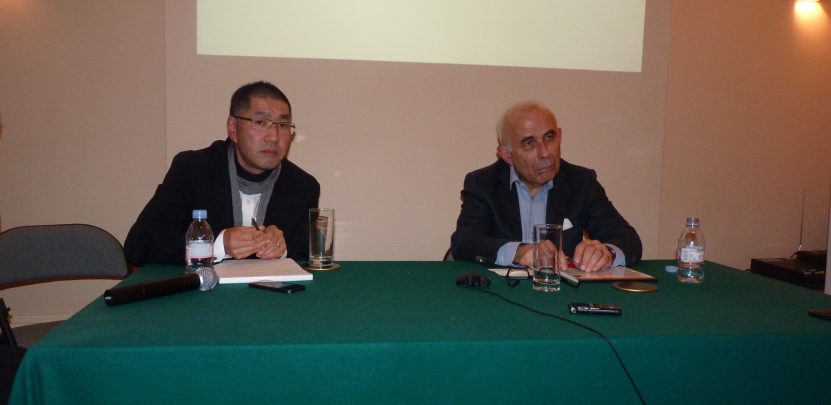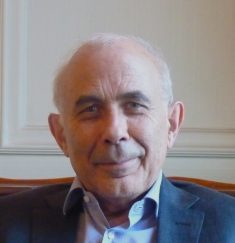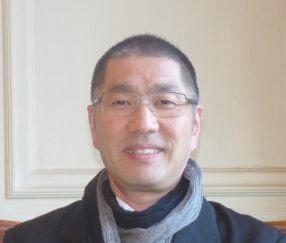
'Life Palace (Tea Room),' 2013, photo by Nobutada Omote, Courtesy of the artist and Lisson Gallery
LectureFriday 20 September 2013
6:00pm – 7:30pm
How Do We Perceive Art-Through Vision or Cognition? Neuro-aesthetics and Tatsuo Miyajima
ドリンクレセプション 7:30pm – 8:30pm
13/14 Cornwall Terrace, Outer Circle, London, NW1 4QP
The Daiwa Anglo-Japanese Foundation 主催
We were pleased to invite Professor Semir Zeki, an expert on visual cognition and neuro-aesthetics, to speak with Tatsuo Miyajima, one of the most prominent Japanese artists practising today and who has been influenced by cognitive science. Conceptual approaches to art are familiar to contemporary audiences, yet there remain fundamental questions of what art is and where it originates. There are also questions of aesthetics when the pieces themselves are participant-centred. If science is able to fully explain the experience of art, does it reduce art’s significance?
Miyajima’s practice explores the idea of ‘time’, and our perception of it; representing universal concepts of continuous change, interconnectedness and infinity, which led him to the fundamental belief of ‘Art in You’. He explains this concept: “Art works are nothing more than devices to let people encounter, notice and be impressed by something. Artistic experiences and impressions rest inside the imagination of each human being.” Most of his current activities are based on this theme.
Since achieving international recognition from the late 1980s, his ideas have been explored in interdisciplinary forms of sculpture and performance (such as the Kaki no ki Project for the Japanese Pavilion at the 48th Venice Biennale 1999, and Peace Shadow). Perhaps his most notable motif is the LED digital counter, presented in various forms, sizes, structures, and durations for the numbers 1 to 99 in no sequential order: a reference to Buddhist ideas of reincarnation.
Tatsuo Miyajima’s exhibition I-Model will be held at the Lisson Gallery 52-54 Bell Street, from 27 September to 2 November 2013.
The video of the talk can be viewed below:
コントリビューターについて

Professor Semir Zeki
Professor Semir Zeki is Professor of Neuroesthetics (or Neuro-aesthetics) at University College London (UCL). His PhD in Anatomy is from UCL and between 1980 and 1985 he was Henry Head Research Fellow of the Royal Society, again at UCL. He became a Fellow of the Royal Society in 1990, and also a fellow of the Academia Europaea (1993) and of the European Academy of Sciences and Arts (1995). He was awarded the Erasmus Medal (Academia Europaea) in 2008 and is also the convener of the annual international meeting in neuroesthetics. His research focuses on how the visual brain is organised, using imaging and psychophysical techniques and involves a multi-disciplinary approach that brings together neuroscientists, cognitive scientists and those in the humanities, to address questions that are of deep concern to science and society. He has written four books: A Vision of the Brain (Blackwell, Oxford, 1993); Inner Vision: an exploration of art and the brain (OUP, Oxford, 1999); La Quête de l’essentiel (with the late French painter Balthus; Archimbaud, Paris 1995) and Splendours and Miseries of the Brain (Blackwell 2008).

Professor Tatsuo Miyajima
Professor Tatsuo Miyajima is an artist and Vice President of Tohoku University of Art and Design and Kyoto University of Art and Design. His first international exposure was in 1988 when he presented Sea of Time in Aperto 88 (a section of the exhibition designed to explore emerging art) as part of 43rd Venice Biennale. He has taken part in various residency programmes including in New York (1990, funded by the Asian Cultural Council), in Berlin (1990 – 1991, funded by Deutscher Akademischer Austauschdienst) and in Paris (1993, funded by Fondation Cartier pour l’art contemporain). A 1995 visit to Nagasaki led to his collaboration with Dr Masayuki Ebinuma, a local tree doctor who was growing persimmon trees that miraculously survived the atomic bomb. Viewing the trees as symbols of peace, Miyajima developed a performance piece in which the saplings were given to local children and replanted. Works by the artist are part of collections at the Tate Gallery, London; the Museum of Contemporary Art Chicago and the Museum of Contemporary Art, Tokyo, amongst many others.